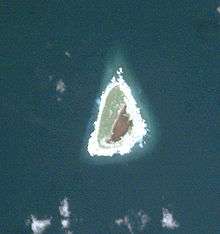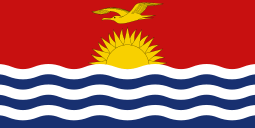Rawaki
Rawaki is one of the Phoenix Islands in the Republic of Kiribati, also known by its previous name of Phoenix Island. It is a small, uninhabited atoll, approximately 1.2 by 0.8 kilometres (0.75 by 0.50 miles) in size and 65 hectares (160 acres) in area, with a shallow, brackish lagoon that is not connected to the open sea. It is located at 3.721°S 170.712°W.

The island is designated as a wildlife sanctuary.[1] Kiribati declared the Phoenix Islands Protected Area in 2006, with the park being expanded in 2008. The 164,200-square-mile (425,000-square-kilometre) marine reserve contains eight coral atolls including Rawaki island.[2][3]
Flora and fauna
Rawaki has been described as being ham or pear shaped.[4] Its highest elevation is approximately six meters. It is treeless, being covered mostly with herbs and grasses, and thus forms an excellent landing and nesting site for migratory seabirds and turtles. Unlike many other Pacific islands, no rats were noted on Rawaki during a 1924 scientific expedition.[4] A colony of feral rabbits was introduced in the nineteenth century, but was eliminated in 2008.[5][6]
Rawaki has its own species of seabird tick, Ixodes amersoni.[7] It also boasts various species of flies, moths, leafhoppers, green bugs, and spiders. Sea birds consist of sooty, grey, and white terns; frigates, petrels and shearwaters; boobies, migratory plover and curlew.[4] Rawaki has never been invaded by rats so that the bird populations have survived.[5]
History
Unlike some other islands in the Phoenix group, Rawaki does not seem to have ever been inhabited by prehistoric Polynesians or other Pacific islanders.[4]
Rawaki was discovered on 23 February 1824 by Capt. John Palmer from the London whaling ship Phoenix. It was claimed for the U.S. under the Guano Islands Act on March 14, 1859 by C.A. Williams and Company, later the Phoenix Guano Company.[8] The company mined guano on the island until the supply was exhausted in August 1871, when the islands were abandoned.[9] This claim was later relinquished in the Treaty of Tarawa. On June 29, 1889, a British protectorate was declared, and the island surveyed.[8] On March 18, 1937, it was placed under the jurisdiction of the Gilbert and Ellice Islands. It later became part of Kiribati.
In 2008, Rawaki was placed, together with the other Phoenix Islands, within the Phoenix Islands Protected Area, one of the largest marine protected areas in the world.
See also
- List of Guano Island claims
- List of islands
- Desert island
References
- Edward R. Lovell, Taratau Kirata & Tooti Tekinaiti (September 2002). "Status report for Kiribati's coral reefs" (PDF). Centre IRD de Nouméa. Retrieved 15 May 2015.
- Brian Clark Howard (16 June 2014). "Pacific Nation Bans Fishing in One of World's Largest Marine Parks". National Geographic News. Retrieved 15 May 2015.
- Editor. "Phoenix Islands Protected Area". Government of Kiribati. Retrieved 25 January 2015.CS1 maint: extra text: authors list (link)
- Resture, Jane. "Phoenix Island". Jane Resture. Retrieved 25 January 2015.
- Jamieson, Regen (18 April 2014). "Removing Rats and Rabbits: An Interview with Ray Pierce". New England Aquarium - Phoenix Islands Blog. Retrieved 25 January 2015.
- Pierce, Ray; Anterea, Nautonga; Coulston, Glen; Gardiner, Clea; Shilton, Louise; Taabu, Katareti; Wragg, Graham. "Executive Summary of the 2009 Invasive Species Removal Report". ATOLL RESTORTION IN THE PHOENIX ISLANDS, KIRIBATI: SURVEY RESULTS IN NOVEMBER-DECEMBER 2009. Phoenix Islands Protected Area. Retrieved 24 April 2014.
- Kohls, GM (April 1966). "A new sea bird tick, Ixodes amersoni, from Phoenix Island (Acarina: Ixodidae)". J. Med. Entomol. 3 (1): 38–40. doi:10.1093/jmedent/3.1.38. ISSN 0022-2585. PMID 5941563.
- Bryan, Edwin H. Jr. (1942). American Polynesia and the Hawaiian Chain. Honolulu, Hawaii: Tongg Publishing Company. p. 55. OCLC 1036237.
- Hydrographic Department, Great Britain (1885). "Pacific Islands".
Further reading
- Dalton, William, The Dalton journal: two whaling voyages to the South seas, 1823-1829, Niel Gunson, ed.; Sydney: National Library of Australia, 1990 ISBN 0-642-10505-7
External links
- Oceandots page with satellite photo at the Wayback Machine (archived December 23, 2010)
